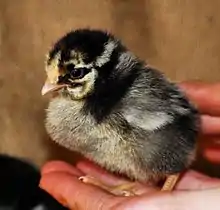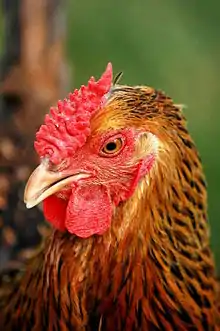Wyandotte chicken
The Wyandotte is an American breed of chicken developed in the 1870s. It was named for the indigenous Wyandot people of North America.[6] The Wyandotte is a dual-purpose breed, kept for its brown eggs and its yellow-skinned meat.[6] It is a popular show bird, and has many color variants.[4] It was originally known as the American Sebright.[1]
.jpg.webp) The silver-laced, the original variety of the breed | |
| Conservation status | not at risk[1] |
|---|---|
| Other names | American Sebright (before 1883)[1] |
| Country of origin | United States |
| Use | dual-purpose |
| Traits | |
| Weight | |
| Skin color | yellow |
| Egg color | brown |
| Comb type | rose |
| Classification | |
| APA | American[3] |
| EE | yes[4] |
| PCGB | soft feather: heavy[5] |
| |
History
The Wyandotte was created in the United States in the 1870s by four people, H. M. Doubleday, John Ray, L. Whittaker and Fred Houdlette.[6] The first type was the silver-laced, which was included in the American Standard of Perfection of the American Poultry Association in 1883; it was taken to Britain at about the same time.[2]: 311 [3] It had previously been known as the Sebright Cochin or American Sebright.[7]: 46 The origin of the breed is unknown; it is thought derive partly from spangled Hamburgs and dark Brahmas[1] – the Hamburg for the rose comb and the Brahma for the color pattern.[7]: 46
The gold-laced Wyandotte was produced by breeding silver-laced hens with gold-spangled Hamburg and partridge Cochin cocks, the white Wyandotte was a sport of the silver-laced, and the buff variant came from crossing the silver-laced with buff Cochin stock;[2]: 311 the black variant was also a sport, of both the silver-laced and the gold-laced.[6] The partridge Wyandotte came from crossing the gold-laced with Indian Game, partridge Cochin, gold-pencilled Hamburghs, and a strain called "Winnebago".[6] The Columbian was the result of a chance crossing of white Wyandottes with barred Plymouth Rock birds; it was named for Columbian Exposition and World's Fair in Chicago, Illinois, in 1893.[6][2]: 311 The first Wyandotte bantams were added to the Standard of Perfection in 1933.[3]
In 2015 the Wyandotte was listed as "recovering" by the American Livestock Conservancy;[8] in 2016 it was no longer considered to be in danger and was removed from the priority list.[1] In Germany it is listed in category IV, "alert", on the Rote Liste of the Gesellschaft zur Erhaltung alter und gefährdeter Haustierrassen.[9]
Characteristics


The Wyandotte is a fairly large bird, with weights for adult birds in the range 2.7 to 4 kg (6 to 9 lb).[1] The body is of medium length, broad in the back and with a deep, full and well-rounded breast.[7] It is clean-legged and fairly close-feathered, and has a broad skull with a rose comb.[2]: 311 The skin and shanks are yellow,[6] and the ear-lobes, face and wattles are red.[1]
Silver-laced Wyandotte cocks may occasionally display hen feathering.[10]: 85–86
In the United States, nine color varieties are recognized by the American Poultry Association: black (1893), blue (1977), buff (1893), Columbian (1905), golden laced (1888), partridge (1893), silver laced (1883), silver penciled (1902) and white (1888).[3] For bantams, the same nine colors are recognized, with the addition of buff Columbian.[3]
In Europe, the Entente Européenne lists thirty colors.[4] The Poultry Club of Great Britain recognizes barred, black, blue, blue-laced, blue partridge, buff, buff-laced, Columbian, gold-laced, partridge, red, silver-laced, silver-pencilled and white.[2]: 312–317
Use
The Wyandotte is a dual-purpose breed, raised both for eggs and for meat. It matures moderately rapidly, and hens are good layers of large brown eggs.[1] It is a popular show bird, particularly in Germany.[6]
References
- Wyandotte Chicken. The Livestock Conservancy. Archived 7 June 2015.
- Victoria Roberts (2008). British Poultry Standards: complete specifications and judging points of all standardized breeds and varieties of poultry as compiled by the specialist breed clubs and recognised by the Poultry Club of Great Britain. Oxford: Blackwell. ISBN 9781405156424.
- APA Recognized Breeds and Varieties: As of January 1, 2012. American Poultry Association. Archived 4 November 2017.
- Liste des races et variétés homologuée dans les pays EE (28.04.2013). Entente Européenne d’Aviculture et de Cuniculture. Archived 16 June 2013.
- Breed Classification. Poultry Club of Great Britain. Archived 12 June 2018.
- Edgar L. Petty (2001). Wyandottes: The American Breed with an Indian Name and Eurasian Background. SPPA Bulletin 6 (4): 4–6. Society for the Preservation of Poultry Antiquities. Accessed August 2014.
- [Standard Revision Committee] (1985). The American Standard of Perfection: A Complete Description of All Recognized Breeds and Varieties of Domestic Poultry. Troy, New York: American Poultry Association.
- Conservation Priority Poultry Breeds 2015. The Livestock Conservancy. Archived 15 October 2015.
- Gemeinsame Liste alter und einheimischer Geflügelrassen in Deutschland der GEH und des BDRG (in German). Gesellschaft zur Erhaltung alter und gefährdeter Haustierrassen. Accessed July 2016.
- Lewis Stevens (1991). Genetics and Evolution of the Domestic Fowl. Cambridge: Cambridge University Press. ISBN 9780521403177. doi:10.1017/CBO9780511525780.007. (subscription required)